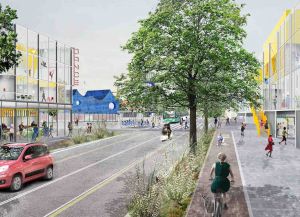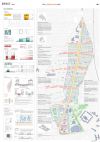
SHORTLISTED PROJECT
TEAM REPRESENTATIVE:
Nina ARTIOLI (IT) - architect
ASSOCIATES:
Eliana SARACINO (IT) - architect
Alessandra GLORIALANZA (IT) - architect
CONTRIBUTORS:
Angelica PALUMBO (IT) - architect
Emiliano QUARESIMA (IT) - architect
Raffaella TOSCANO (IT) - architect
Silvia DE LISI (IT) - architect
BASED IN:
Rome - ITALY
THE COLLABORATIVE MILE
TEAM STATEMENT
“The vision consists in turning Kärntner Straße, an ordinary suburban access road to the city, into The Collaborative Mile, a well-defined district with specific features (physical, relational and intangible) based on the principles of sharing:
> resource sharing
(taking advantage from the opportunities and resources of each actor that operates at different scales on the territory)
> knowledge sharing
(creating incubators and spaces that facilitate short circuiting between ideas and different skills)
> economy sharing
(both resulting from new productive models, that group together production, services, research and training around related issues, and both generated by the new demand posed by new inhabitants and city-users, that creates new job opportunities for residents)
> transformative capacity sharing
(only by collaborating and combining resources and goals it will be possible to put into action a transformation that responds to an overall image).
But if everything is entrusted to the goodwill and initiative of individuals, how can a coherent urban growth be possible? How can the public subject control, guarantee and facilitate this process of urban growth?
It is necessary to define:
1. the general rules, a system of strategic guidelines based on a decalogue (>> THE RULES) that define the structure and the development principles.
2. typologies of intervention (>> THE INGREDIENTS) which, depending on the specified goals and opportunities, can be realized on the territory. They concern: type of buildings, defined in their functional mix, size and formal characteristics; street types (High Street, Active Street, Quiet Street), defined by new road sections and the corresponding buildings density; lastly, the type of public spaces (Multiple surfaces, Community Courtyards, Passages), defined by the public pole to which they are connected (Urban, Starter, Catalyst, Pill), diversified in intensity and attractiveness.
3. the operating mechanism (>>THE PROCESS), that is, the procedural method that allows to tactically catch the opportunities that unexpectedly come up over time. The Kärntner Collaborative Agency, a municipal council unit in the Collaborative Mile, will play a key role during the process (in promoting the transformative possibilities between residents and local operators, in supporting projects development, in coordination, in organizing events and in space management).”


